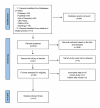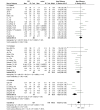The clinical efficacy and safety of platelet-rich plasma on frozen shoulder: a systematic review and meta-analysis of randomized controlled trials
- PMID: 39242516
- PMCID: PMC11378644
- DOI: 10.1186/s12891-024-07629-1
The clinical efficacy and safety of platelet-rich plasma on frozen shoulder: a systematic review and meta-analysis of randomized controlled trials
Abstract
Objective: To systematically review the clinical efficacy (pain, function, quality of life) and safety of platelet-rich plasma (PRP) in the treatment of frozen shoulder through meta-analysis, and provide evidence-based medical evidence for the effectiveness of PRP in the treatment of frozen shoulder.
Methods: A search was conducted on international databases (Pubmed, Web of science, Embase) and Chinese databases (CNKI, Wanfang, VIP) to search the clinical studies on the efficacy of platelet-rich plasma in treating frozen shoulder (adhesive capsulitis/periarthritis/50 shoulder) and their corresponding references published from inception until January 2024. Thoroughly excluded literature not meeting the predetermined inclusion criteria, extracted relevant data from the literature, and input it into RevMan5.4 for meta-analysis.
Results: This study ultimately included 14 RCTs, with a total of 1024 patients. The results showed that PRP has significant advantages compared with control groups in VAS (mean difference (MD) =-0.38, 95% confidence interval(CI)(-0.73, -0.03), P = 0.03), UCLA (MD = 3.31, 95% CI (1.02,5.60),P = 0.005), DASH (MD = -4.94,95% CI (-9.34, -0.53),P = 0.03), SPADI (SPADI Total: MD =-16.87, 95% CI (-22.84, -10.91), P < 0.00001; SPADI Pain: MD =-5.38, 95% CI (-7.80, -2.97), P < 0.0001; SPADI Disability: MD =-11.00, 95% CI (-13.61,-8.39), P < 0.00001), and the active and passive Range of Motion (active flexion: MD = 12.70, 95% CI (7.44, 17.95), P < 0.00001; passive flexion: MD = 9.47, 95% CI(3.80, 15.14), P = 0.001; active extension: MD = 3.45, 95% CI(2.39, 4.50), P < 0.00001; active abduction: MD = 13.54, 95% CI(8.42, 18.67), P < 0.00001; passive abduction: MD = 14.26, 95% CI (5.97, 22.56), P = 0.0008; active internal rotation: MD = 5.16, 95% CI (1.84, 8.48), P = 0.002; passive internal rotation: MD = 3.65, 95% CI(1.15, 6.15), P = 0.004; active external rotation: MD = 10.50, 95% CI(5.47, 15.53), P < 0.0001; passive external rotation: MD = 6.00, 95% CI (1.82, 10.19), P = 0.005) except passive extension (MD = 2.25, 95% CI (-0.77, 5.28), P = 0.14). In terms of safety, most studies reported no adverse effects, and only one study reported common complications of joint puncture such as swelling and pain after treatment in both PRP and control groups. Previous studies have shown a risk of osteonecrosis caused by corticosteroids. Therefore, the safety of PRP treatment is more reliable.
Conclusion: The results showed that PRP was more durable and safer than corticosteroids and other control groups in the treatment of frozen shoulder.
Study design: Systematic review.
Trial registration: PROSPERO CRD42022359444, date of registration: 22-09-2022.
Keywords: Adhesive capsulitis; Frozen shoulder; Meta-analysis; PRP; Periarthritis of shoulder; Platelet-rich plasma; Randomized Controlled Trials.
© 2024. The Author(s).
Conflict of interest statement
The authors declare no competing interests.
Figures
References
-
- Ewald A. Adhesive capsulitis: a review. Am Fam Physician. 2011;83(4):417–22. - PubMed
-
- Pinnaka VS, Thati B, Sunkara R. A R. A comparative study on the effectiveness of platelet rich plasma injection versus corticosteroid injection in treatment of adhesive capsulitis of shoulder. Trends Clin Med Sci 2021; SI: Recent developments ofmedical and surgical research 476–485. 10.30538/psrp-tmcs2023.si-rdmsr066.
Publication types
MeSH terms
Grants and funding
- 2021MS454/Sichuan Provincial Administration of Traditional Chinese Medicine
- 22-B07/The special fund for 100 Talents Program of the Affiliated Hospital of Chengdu University of TCM
- 030058047/The scientific research promotion plan of "Xinglin Scholars" Discipline Talents of Chengdu University of Traditional Chinese Medicine
LinkOut - more resources
Full Text Sources
Medical
Research Materials







